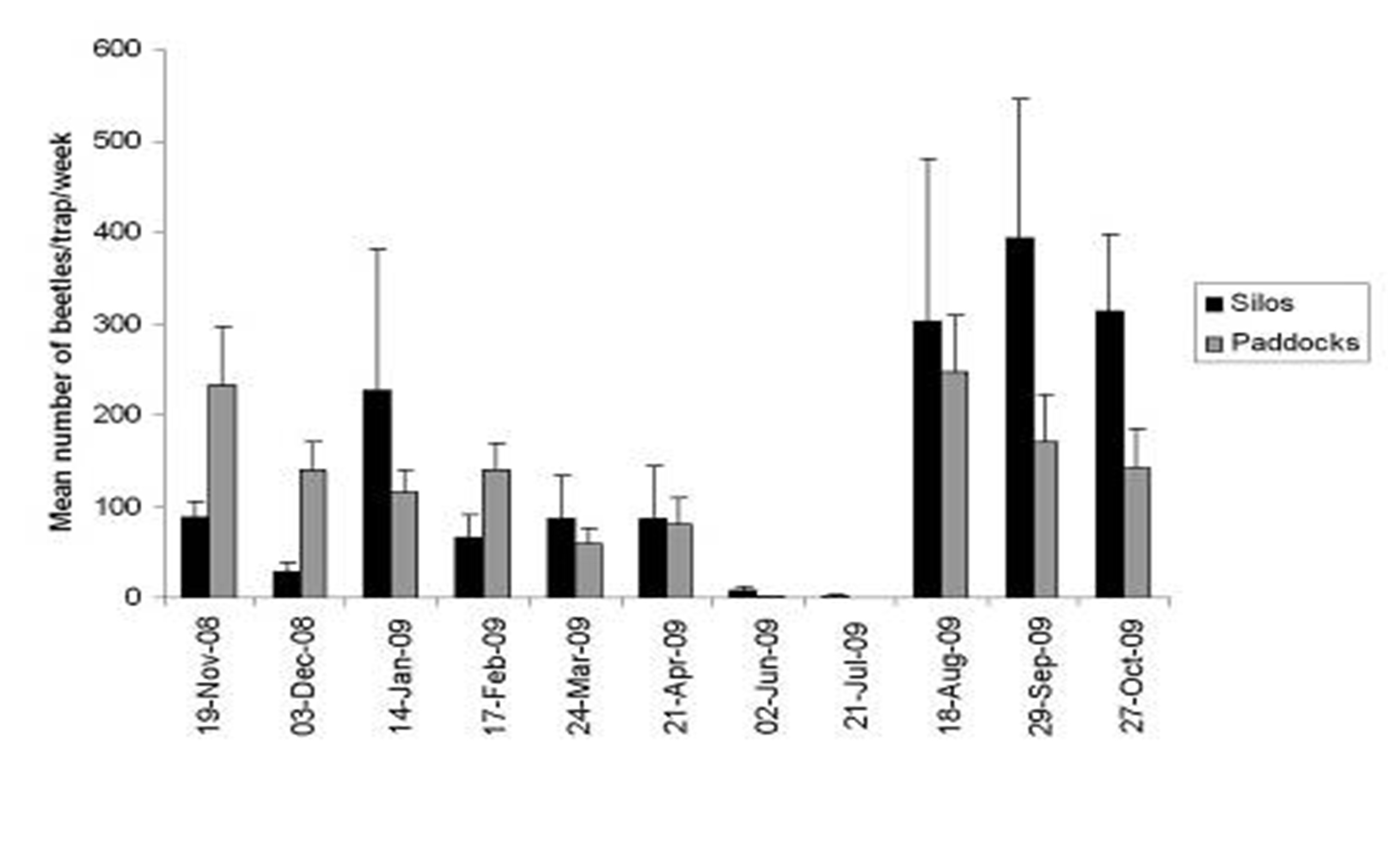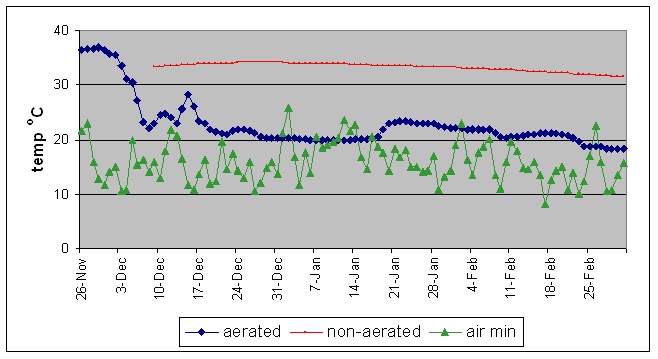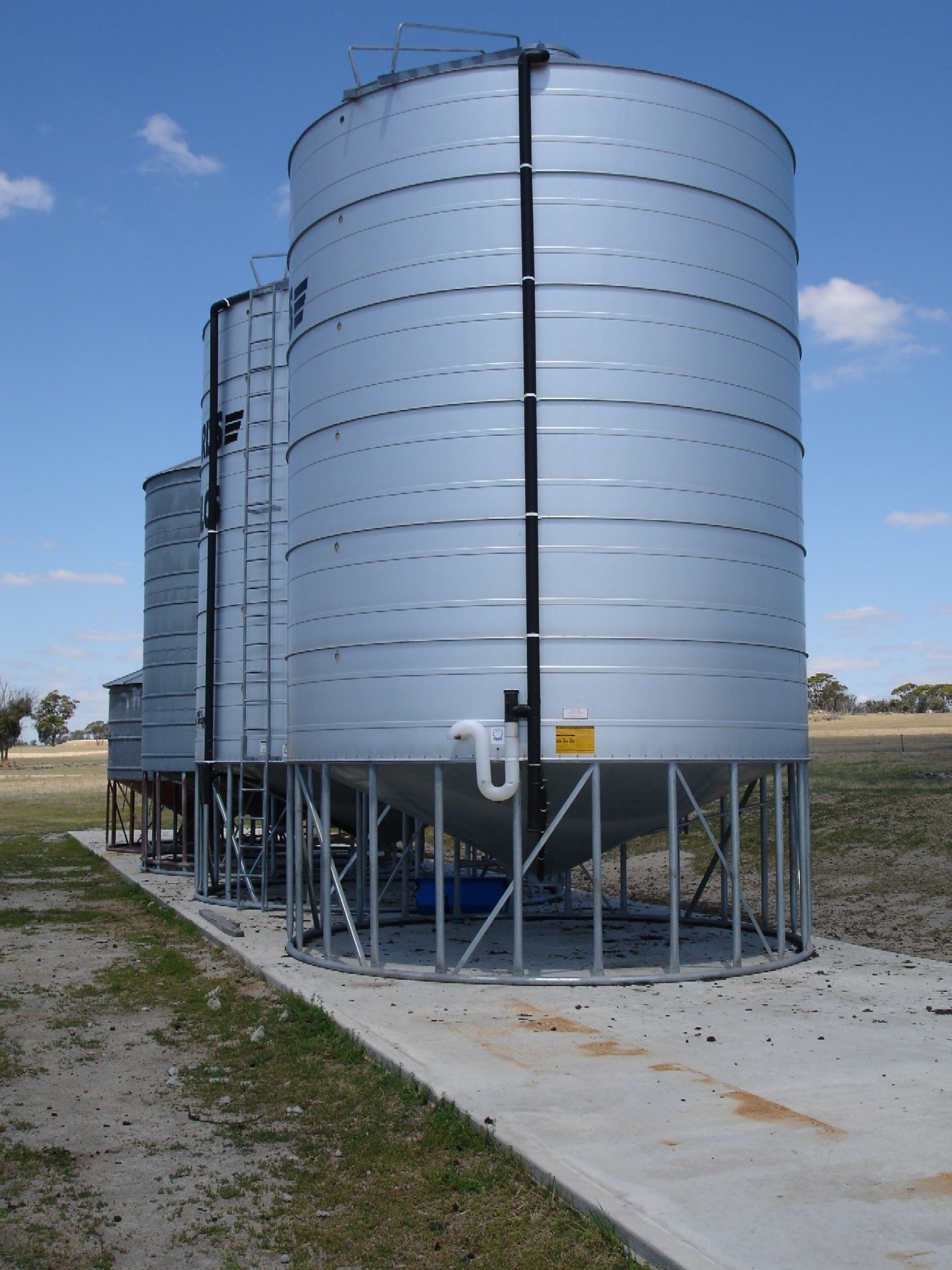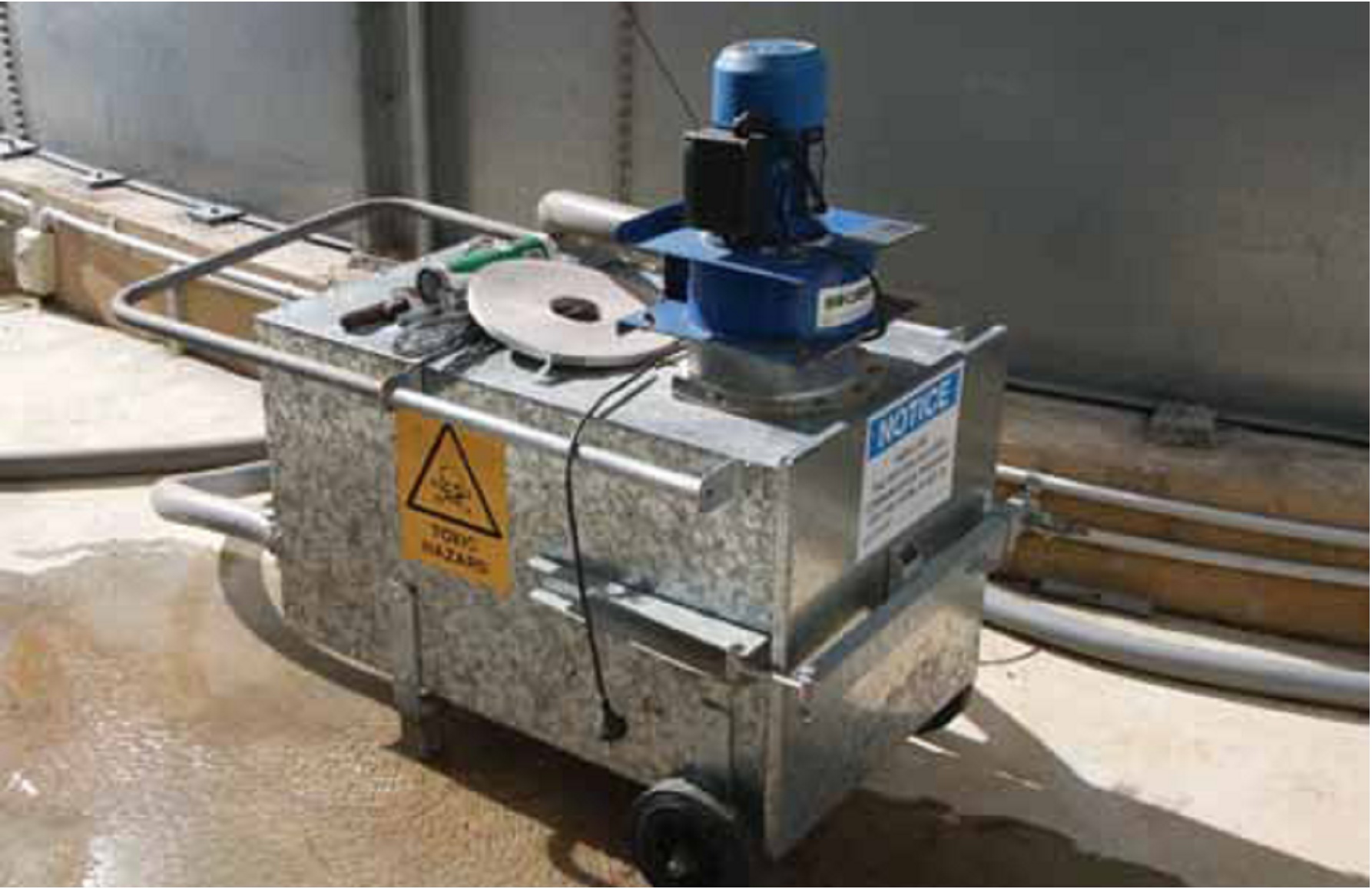Grain Storage Future pest control options and storage systems 2013 2014
Author: Philip Burrill, DAFF Hermitage Research Facility, Warwick Qld. | Date: 18 Jul 2013
Philip Burrill, DAFF Hermitage Research Facility, Warwick Qld.
Take home messages
- Combining “good hygiene”, well managed “aeration cooling” along with regular “grain inspections” provides the best foundation for successful grain storage.
- Recent ecology research findings which involved trapping flying storage pests across grain growing regions reinforced the value of cleaning up grain residues in storages & equipment
- Lesser grain borer‘s (Rhyzopertha dominica) widespread resistance to grain protectants is ending with the availability of deltamethrin (eg K-Obiol) and spinosad (eg Conserve On-Farm)(hopefully to be registered by the end of 2013) products.
- New easy to use functions in Automatic aeration controllers provide improved reliability of achieving good results from aeration cooling.
- Darling Downs producers should achieve grain temperatures in storage of 20 to 23°C during summer storage and less than 15°C in winter.
- Fumigation – “recirculation” and “ground level applications” has a role to play in effective, safe fumigations.
Gaining a better understanding of the insect pests themselves and fighting them using the right combination of management and equipment gives you the upper hand. With a deregulated market there is an increasing range of domestic and export selling options. Growers strengthen their position when their storage facilities allow flexibility with grain handling and timing of sales.
As a bonus, many of the strategies used to minimise pest problems also significantly improve storage conditions for maintaining grain quality. Cereals grains, pulses, oilseeds and planting seed all benefit.
Established strategies
There is an increasing number of growers who are reaping rewards by placing extra emphasis on the management of their grain storage facilities. It is the “combination of practices” listed below that provide the real strength to successful storage. Key strategies include:
- High standard of hygiene for storages & grain handling equipment - minimising insect pest breeding sites
- Monthly checks of grain in storage, including planting seed – sieving for insects & checking quality
- Aeration – aeration fans fitted to storages, operated by an automatic controller
- Grain temperatures – checked and achieving 20 - 23°C in summer and less than 15°C in winter
- Fumigations, when required, are carried out in sealable silos. These silos are pressure tested at least once per year. See the GRDC fact sheet – “Pressure testing sealable silos”
- Storage record keeping – a simple system is used to record details such as: grain variety, moisture content, any treatments, inspections dates and data for: insects, grain temperature
New products & equipment
- K -Obiol Combi ® (50g/L deltamethrin, 400g/L Piperonyl Butoxide). – Bayer CropScience
This grain protectant insecticide formulation registered by Bayer was restricted for use by the Bulk Handling companies such as Graincorp for a number of years. After lengthy negotiations’ it has now been released for use by grain growers who meet two key requirements. The grower undertakes a training course in its correct use and has a recognized QA system on their property. Further details can be found in GRDC’s Ground Cover publication (Sept - Oct 2012 p.22) or contact Bayer.
For growers it is currently the only protectant registered in Australia with acceptable efficacy against the common storage pest, lesser grain borer (Rhyzopertha dominica), which has developed widespread resistance to current insecticides. It is worth noting however that insect resistance surveys in the past consistently detected low levels of deltamethrin resistant insect strains in the industry. This is a warning that resistance populations could increase quickly if there was widespread excessive use of one product.
- Conserve™ (Spinosad) - Dow AgroSciences
Now registered in Australia as a grain protectant insecticide. The APVMA approved in February 2013, Conserve™ Grain Protector, for exclusive use by approved Bulk Handling companies, and is aiming to have Conserve™ On-Farm grain protector available for growers before the end of 2013.
Spinosad, one of three active ingredients in Conserve On-Farm, will provide up to 9 months control of the key pest, lesser grain borer (Rhyzopertha dominica). It will be sold as a twin pack combination, with the partner product Reldan Plus, to control all the other key stored grain insect pests.
The proposed stewardship program for Conserve On-Farm, will require agents selling Conserve to be accredited, and manage an end user declaration (EUD) process. To complete the end user declaration, growers provide their NGR details, understand and agreeing to the conditions of use at the point of sale. It will be registered for use on all cereal grains excluding maize, malt barley and rice, with a single application restriction to ensure MRL’s are not exceeded. Whilst only a 24 hour WHP will apply, the EUD condition of use requires growers declare all Conserve On-Farm treatments by using a Commodity Vendor declaration (CVD). This ensures future owners of the grain can manage the spinosad residues, and avoid double application.
- ProFume ® (998g/kg Sulfuryl Fluoride)
Is a relatively new fumigant for grains in Australia, registered by Dow AgroSciences. It comes in gas cylinders and may only be applied by licensed fumigators who have completed a specific training course designed by Dow. It is registered for use on cereal grains, but not for pulses or oilseeds. Like phosphine it still requires a well sealed – gas-tight storage to hold the gas concentration for the required 4 to 6 day fumigation period. Cost of treatment ranges from $3 to $7 per tonne depending on tonnage, storage type, and distance the licensed fumigator needs to travel. When compared to 35 - 40c per tonne for a standard on-farm phosphine treatment, it is expensive. There are also industry concerns as Sulfuryl Fluoride (SF) is a greenhouse gas and does leave fluoride residues in grain. However SF currently has a very important role in Australia’s grain industry as a “phosphine resistance breaker” especially targeting strong resistant flat grain beetle Cryptolestes ferrugineus, currently a problem in bulk handling facilities and a few farms. For more information on ProFume® contact Dow AgroSciences Aust Ltd – 1800 700 096, www.dowagro.com.au
- Aeration – Automatic controllers
Reliability of achieving good results with aeration cooling is significantly increased with automatic controllers turning on silo fans when the best ambient temperature and humidity conditions are available. Two companies based in Toowoomba Qld. (CustomVac Aust., Agridry International) have recently incorporated new functions in their automatic aeration controllers. Examples include: the ability to have fans automatically step through the 3 important stages of aeration cooling – “continuous”, “purge”, “protected”; an additional auto function that now excludes high humidity air (>85% RH) in all three of these stages; a setting that can be included that adjusts fan operations to cater for fans fitted to silos with air flow rates higher then the standard 2 – 3 L/s/t flow rates. These new practical functions are another good reason to no longer use the less reliable methods of trying to remember to manually switch fans on and off, or using power point time clocks.
- High flow rotary grain cleaner
One of benefits of having on farm storages is the ability to segregate various quality grades of grain at harvest time. If you are just missing a premium grade due to a few extra percent screenings in wheat, or you could face down grades in pulses due to splits or weed seed contamination, grading is an option that can quickly add value.
Storage safety is also improved by grading out impurities and fines from oilseeds,during the silo filling operation. The new rotary grader has multiple screen tubes designed for flow rates that will keep up with most harvesting operations. A range of screen sizes and slot designs suit most grading requirements. Contact - Customvac Aust. Toowoomba.
Maintaining grain quality in storage
The two most common, serious threats to grain quality in Australia’s storages are insect pest infestations and grain moisture problems causing mould / fungal growth. Key initial strategies include through hygiene for storages and equipment, plus aiming for “cool, dry grain” in storage.
The high numbers of storage pest that can fly out from on-farm sources of infested grain in spring and summer looking for newly harvest clean grain to infest demonstrates the value of regular hygiene activities and grain inspections. See Fig, 1 & 2.
Grain temperatures below 15°C stop the breeding life cycle for all of our common storage pests. During summer, achieving grain temperature close to 20⁰C is also valuable as it either stops or significantly slows insect population increase.
Grain fungal growth in storage is kept in check with appropriate grain moisture contents – e.g. wheat less than 12.5%, sorghum less than 13.5%. Lower grain temperatures also assist to some extent in reducing fungal growth.
Attention paid to the three areas listed below will provide reliable grain quality outcomes:
- Good storage & equipment hygiene – reduces early pest infestations & grain contamination problems. Sieve & inspect grain in storages monthly.
- High moisture grain in storage – have the right equipment & management to deal with it promptly. Monitor regularly.
- Cool grain temperatures - use aeration to achieve cool, uniform moisture conditions in storages in the first few weeks after harvest. Monitor and maintain these conditions.

Figure 1. Numbers of Lesser grain borers (Rhyzopertha dominica) trapped in warm and cooler months at farm silos and one km away in the paddocks. Greg Daglish DAFF Qld.
Aeration cooling – achieving reliable results
Tips for producing the best results using aeration:
- Fan operations - do not rely on manual switching or time clocks to operate fans. Auto controllers provide reliable, consistent cool grain temperatures. Purchase your auto controller from a trustworthy supplier.
- Maintenance – manually test individual silo fans to check there are no electrical faults. For auto controllers, check the temperature / humidity sensor is clean. Also compare its readings, with a reliable hand held thermometer & RH reader.
- Fan operations – ensure fans are stepped through the 3 important stages of aeration cooling. The most recent auto controller models now automate this procedure over the first 2 weeks for storage. eg GrainSafe 5000
- Fan performance - during 2011- 2012 an Australian research group developed a simple, accurate method for testing the air flow performance of aeration fans while they are operating. The recommended air flow rate for cooling grain is 2 to 3 litre of air, per second, per tonne of grain in the storage. Field tests on farm storages have shown some fans are not delivering required air flow rates. See GRDC Fact sheet “Performance testing aeration systems” August 2012.
- No aeration fans fitted to storages - growers may not be convinced aeration of grain is worthwhile or a valuable asset for his storage system in his region. It is typical to reduce grain temperatures by at least 10°C with a well managed aeration system. This has a significant impact on reducing insect pest problems and maintaining grain quality. For Queensland and northern NSW, wheat in storage using aeration during summer should be targeting grain temperatures of 20 - 23°C. See graphs Fig. 2

Figure 2. Comparison of wheat grain temperatures in aerated and non aerated silos, NSW Barry Wallbank
Fumigation – research results and commercial applications
A. Fumigating in silo bags
In some situations growers may find it difficult to gain access to a sealable, gas-tight silo in which to carry out an effective fumigation of infested grain. Recent trials have shown a silo bag can be used successfully for fumigation with phosphine when using the correct procedure.
Key steps:
- A gas-tight seal - inspect the silo bag and repair any minor holes
- Correct phosphine tablet dose - apply in multiple grain spears evenly placed 7 m apart
- Allow a 14 day fumigation period
- Vent the gas safely using a standard F650 aeration fan
For further details search GRDC web site for “Fumigation in a silo bag with phosphine”, or see Grains Research Update newsletter – Northern region, Summer 2010
- Fumigating in silos - recirculation, Thermo siphons, ground level application of phosphine
What is “recirculation” and “Thermo siphons” and when should they be used?
Standard recommended practice for phosphine application has been to place tablets in trays in the sealed silo headspace. For small and medium size silos of less then 150 tonnes capacity this is an effective application method. The phosphine gas only takes approx 24 hours to diffuse from the top to the bottom, through the 5 to 7 meter depth of grain to the base of the silo.
For larger, taller silos ( > 150 tonnes) however it can take 2 or more days for phosphine gas to reach the grain in the base of the silo. This can be a problem for a standard 7 or 10 day fumigation, because some infested grain at the silo base does not have enough exposure time at high gas concentrations to kill all stages of the insects.
Recirculation is simply a system of adding plumbing / pipes to the silo to connect the silo base with the top of the silo to speed up the movement of gas through all grain in the silo. Recirculation should provide a faster, more uniform gas distribution. Growers will now see a number of silo manufactures offering silos fitted with PVC tubes running down the outside of silos from top to bottom. The complete system, including the silo itself, still needs to be well sealed, gas-tight. Otherwise gas simply leaks out and the fumigation will fail to kill all the pests.
- “Recirculation” usually involves using a small aeration fan connected into the plumbing system to force the phosphine gas distribution around the silo. The critical time to have this operating is during the first 3 or 4 days while tablets are liberating gas.
- “Thermo siphons” have the same silo roof to silo base plumbing arrangement aiming to achieve gas movement (recirculation) around the silos without the use of an electric fan. The heating and cooling of the silo head space and the black coloured piping down side of the silo, helps generate air currents which distribute the phosphine gas.
- “Ground level application” To assist with safety and reduce the amount of time climbing silos to place tablets, phosphine tablets or bag chains can be placed in appropriate ‘ground level’ structures or containers at the silo base. These are often part of a recirculation system and connect to the internal aeration ducting. It is very important to ensure the systems design has ample space for tablets with free gas flow to prevent the phosphine gas concentrations building up above the flammable limit (explosive), above 17,000 ppm. Do not restrict gas movement with small containers for tablets or small diameter pipe plumbing while gas is liberated in the first 3 – 4 days. Seek advice to ensure only safe designs are used.

Figure 3. Sealable, aerated silo fitted with a Thermo siphon to assist with gas distribution during fumigation

Figure 4. Fan forced, ground level phosphine application box which is connected to the top & bottom of a large sealable silo to assist with gas distribution during fumigation
Contact details
Philip Burrill
Department of Agriculture Fisheries & Forestry Qld
Email: philip.burrill@daff.qld.gov.au
Ph: 07 46603 620
Mb: 0427 696 500
Was this page helpful?
YOUR FEEDBACK
